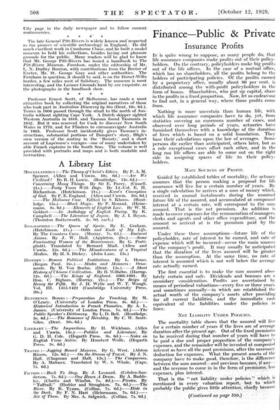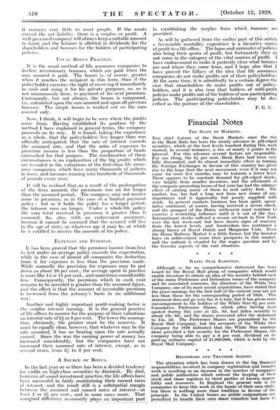Fitiatice Public & Private
Insurance Profits
IT is quite wrong to suppose, as many people do, that life assurance companies make profits out of their policy- holders. On the contrary, policyholders make big profits out of the life offices. In the case of a mutual office, which has no shareholders, all the profits belong to the holders of participating policies. Of the profits earned by a proprietary office, usually about 90 per cent. is distributed among the with-profit policyholders in the form of bonus. Shareholders, who put up capital, share in the profits in a fixed proportion. Now, let us endeavour to find out, in a general way, where those profits come from.
Nothing is more uncertain than human life, with which life assurance companies have to do, yet, from statistics covering an enormous number of cases, and observed over long periods of years, actuaries have furnished themselves with a knowledge of the duration of lives which is based on a solid foundation. They base then' calculations upon the law of averages. Some persons die earlier than anticipated, others later, but as a rule exceptional cases offset each other, and in the long run life offices are able to come out on the right side in assigning spaces of life to their policy- holders.
MAIN SOURCES OF PROFIT.
Guided by established tables of mortality, the actuary assumes that the person making a proposal for life assurance will live for a certain number of years. By a single calculation he arrives at a sum of money which, received in annual instalments • during the assumed future life of the assured, and accumulated at compound interest at a certain rate, will correspond to the sum assured. That is the net premium. An addition is made to cover expenses for the remuneration of managers, clerks and agents and other office expenditure, and the amount so arrived -at is the premium paid by the assured.
Under these three assumptions-future life of the policyholder, rate of interest to be earned, and rate of expense which will be incurred-occur the main sources of the company's profit. It may usually be anticipated that the duration of the lives assured will be greater than the assumption. At the same time, no rate of interest is assumed which is not well below the average rate actually earned.
The first essential is to make the sum assured abso- lutely certain and safe. Dividends and bonuses are a secondary consideration. Profits are ascertained by means of periodical valuations-every five or three years, and sometimes annually-in which are established the actual worth of the company's assets after providing for all current liabilities, and the immediate cash equivalent of the liabilities under the policies in force.
NET LIABILITY UNDER POLICIES.
The mortality table shows that the assured will live for a certain number of years if the lives are of average duration after the present age. Out of the fixed premiums to be received during that number of years will have to he paid a due and proper proportion of the company's expenses, and the remainder will be invested at compound interest as have all the past premiums, after the necessary deduction for expenses. What the present -assets- of the company have to make good, therefore, is the.. difference between the sum assured-and previous bonnseS, if any-- and the revenue to come in in the form of preiniunisi less expenses; plus interest. is That is the " net liability under policies " .which mentioned in every valuation report, but to which probably the public gives little attention; chiefly because (Continued on page 51* ) - it conveys very little to most people. If–the- assets exceed the net liability, there is a surplus or profit. A well-governed company will always keep a suitable amount in hand, and the balance is allotted in dividends for the shareholders and bonuses for the holders of participating policies.
USUAL BONUS PRACTICE.
It is the usual method of life assurance companies to declare reversionary bonuses, which are paid when the sum assured is paid. The bonus is, of course, greater when it reaches the recipient in this form, than if the policyholder exercises the right of receiving it-immediately in cash and using it for his private purposes, or, as is not uncommonly done, in payment of his next- premium. Customarily, but not always, the bonus is compound, i.e.. calculated upon the sum assured and upon all-previous bonuses. The simple bonus is worked out on the sum assured only.
Now, I think, it will begin to be seen where the profits come from. Having established its position by the method I have explained in general terms, the company proceeds on its way.. It is found, taking the experience as a whole, that the policyholders live, longer. than was officially anticipated, that the rate of interest exceeds the assumed rate, and that the ratio of expenses to premium income is less than the proportion .of funds earmarked 'for that purpose. The combinatidn of these circumstances is an explanation of the big profits which are revealed in the valuations of the first-class life assur- ance companies, which have many thousands of policies in force, and incomes running into hundreds of thousands of pounds every year.
It will be realized that, as a result of the prolongation of the lives assured, the premiums run on for longer than the assumed period. The company may not receive more in _premium, as in the case of a limited payment policy ; but as it holds the policy for ,a - longer period, the interest runs on longer. Under a whole-life policy the sum total received in premium is greater than is assumed. So, also, with an endowment assurance, because it cannot be assumed that the assured will live- to the age of sixty, or whatever age it may be, at which he is entitled to receive the amount of his policy. .
. EXPENSES AND INTEREST. .
It has been proved that the premium income from first to last under an average policy exceeds the expectation, while in the case of almost all companies the deduction from it for expenses is less than the provision made. While normally the provision for expenses may be put down as about 20 per cent., the average spent in practice is more like 14 or 15 per cent., and sometimes considerably less. Consequently, the premium which in each year remains to be invested is greater than the assumed figure, and the effect is that the amount of investable premium is increased from the actuary's basis in an additional way.
Another and highly important profit-making factor is the surplus interest earning. It is the general practice of life offices to assume for the purpose of their valuations an interest rate of 24 or 3 per cent.- The lower the assump- tion, obviously, the greater must be the reserves. It must be equally clear, "however, that whatever may be the rate assumed, it has no bearing upon the rate actually earned. Since the war the earning power of money has increased considerably, but the companies have not increased their assumed rate of interest, except, as in several cases, from 21 to 3 per cent.
A SOURCE OF BONUS.
In the last year or so there has been a decided tendency for yields on high-class securities to diminish. By dint, however, of sound investment practice, the life offices have been successful in fairly maintaining their earned rates of interest, and the result still is a substantial margin between the assumed and earned rates of interest—at least 2 or 24 per cent., and in some cases more. That marginal difference necessarily plays an important part • in establishing the surplus from which bonuses are provided.
As will be gathered from the earlier part of this article a favourable mortality experience is a lucrative source of profit to a life office. The lapse and surrender of policies also bring their quota of profit, but fortunately they do not come in the category of the vital sources of profit. I have endeavoured to make it perfectly clear what bonuses are and where they come from, and I hope also that I have proved the fallacy of the idea that life assurance companies do not make profits out of their policyholders, At the same time, it is admittedly to a certain degree the case that shareholders do make profits out of policy- holders, and it is also true that holders of with-profit policies make profits out of the holders of non-participating policies. The participating policyholder may be des- cribed as the partner of the shareholder.
F. G. C.









































 Previous page
Previous page